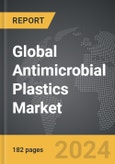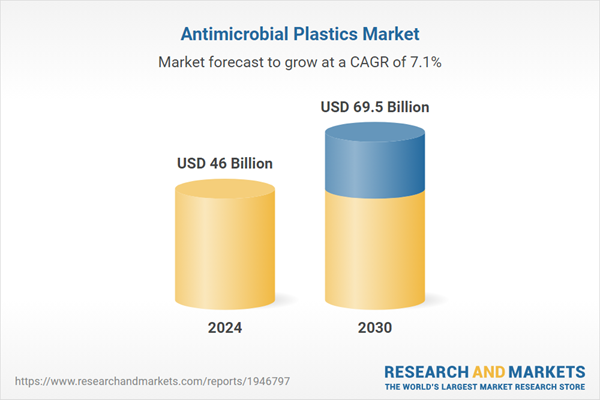Antimicrobial Plastics - Key Trends and Drivers
Antimicrobial plastics are engineered materials infused with antimicrobial agents to inhibit the growth of microorganisms such as bacteria, fungi, and viruses. These plastics are used in various applications where hygiene and sanitation are critical, including healthcare, food packaging, consumer goods, and public facilities. The antimicrobial agents, which can be organic or inorganic compounds, are integrated into the plastic during the manufacturing process. This integration ensures that the antimicrobial properties are embedded throughout the material, providing long-lasting protection against microbial contamination. The effectiveness of antimicrobial plastics is particularly significant in environments prone to the spread of infections, such as hospitals and food processing plants, where they help maintain sterile conditions and reduce the risk of cross-contamination.The demand for antimicrobial plastics has been growing steadily due to increasing awareness of hygiene and the need for infection control. In the healthcare sector, these materials are used in a wide range of products, including medical devices, hospital furnishings, and personal protective equipment (PPE). The food packaging industry also benefits from antimicrobial plastics, which help extend the shelf life of products and reduce the risk of foodborne illnesses. Consumer goods, such as household appliances, textiles, and electronics, are increasingly incorporating antimicrobial properties to enhance product safety and appeal to health-conscious consumers. Additionally, public transportation systems and public facilities are adopting antimicrobial plastics to maintain cleanliness and reassure users about the safety of shared spaces. Technological advancements have led to the development of more efficient and environmentally friendly antimicrobial agents, further broadening the scope of applications and enhancing the performance of these materials.
The growth in the antimicrobial plastics market is driven by several factors. Technological advancements in antimicrobial agents and plastic manufacturing processes have significantly improved the efficacy and durability of these materials, making them more attractive to various industries. The increasing prevalence of healthcare-associated infections (HAIs) and the growing emphasis on hygiene and sanitation in healthcare settings have spurred demand for antimicrobial plastics in medical applications. Consumer behavior trends, particularly the rising health consciousness and demand for safer, more hygienic products, are also propelling market growth. Regulatory requirements and industry standards for infection control and food safety are driving the adoption of antimicrobial plastics in food packaging and processing. Moreover, the ongoing development of sustainable and biodegradable antimicrobial plastics addresses environmental concerns and opens new market opportunities. The COVID-19 pandemic has further highlighted the importance of antimicrobial materials, leading to increased investment and innovation in this field. These factors collectively contribute to the robust growth of the antimicrobial plastics market, ensuring its expansion across diverse sectors and applications.
Report Scope
The report analyzes the Antimicrobial Plastics market, presented in terms of market value. The analysis covers the key segments and geographic regions outlined below.- Segments: Type (Commodity Plastics, Engineering Plastics, High Performance Plastics); Application (Medical & Healthcare, Consumer Goods, Packaging, Automotive, Building & Construction, Other Applications).
- Geographic Regions/Countries: World; United States; Canada; Japan; China; Europe (France; Germany; Italy; United Kingdom; Spain; Russia; and Rest of Europe); Asia-Pacific (Australia; India; South Korea; and Rest of Asia-Pacific); Latin America (Argentina; Brazil; Mexico; and Rest of Latin America); Middle East (Iran; Israel; Saudi Arabia; United Arab Emirates; and Rest of Middle East); and Africa.
Key Insights:
- Market Growth: Understand the significant growth trajectory of the Commodity Plastics segment, which is expected to reach US$44.6 Billion by 2030 with a CAGR of a 6.9%. The Engineering Plastics segment is also set to grow at 8.2% CAGR over the analysis period.
- Regional Analysis: Gain insights into the U.S. market, valued at $12.2 Billion in 2024, and China, forecasted to grow at an impressive 11.4% CAGR to reach $16.1 Billion by 2030. Discover growth trends in other key regions, including Japan, Canada, Germany, and the Asia-Pacific.
Why You Should Buy This Report:
- Detailed Market Analysis: Access a thorough analysis of the Global Antimicrobial Plastics Market, covering all major geographic regions and market segments.
- Competitive Insights: Get an overview of the competitive landscape, including the market presence of major players across different geographies.
- Future Trends and Drivers: Understand the key trends and drivers shaping the future of the Global Antimicrobial Plastics Market.
- Actionable Insights: Benefit from actionable insights that can help you identify new revenue opportunities and make strategic business decisions.
Key Questions Answered:
- How is the Global Antimicrobial Plastics Market expected to evolve by 2030?
- What are the main drivers and restraints affecting the market?
- Which market segments will grow the most over the forecast period?
- How will market shares for different regions and segments change by 2030?
- Who are the leading players in the market, and what are their prospects?
Report Features:
- Comprehensive Market Data: Independent analysis of annual sales and market forecasts in US$ Million from 2024 to 2030.
- In-Depth Regional Analysis: Detailed insights into key markets, including the U.S., China, Japan, Canada, Europe, Asia-Pacific, Latin America, Middle East, and Africa.
- Company Profiles: Coverage of players such as Aspect Software, Inc., Calabrio, Inc., CallFinder, CallMiner, Inc., Envision Telephony, Inc. and more.
- Complimentary Updates: Receive free report updates for one year to keep you informed of the latest market developments.
Some of the 48 companies featured in this Antimicrobial Plastics market report include:
- Addmaster (UK) Limited
- Agion
- American Polyfilm, Inc.
- Americhem, Inc.
- BASF Corporation
- Biocote Limited
- Clariant International Ltd.
- E. I. du Pont De Nemours and Company
- Gelest, Inc.
- Highland Plastics, Inc.
- King Plastic Corporation
- Lonza Group Ltd.
- Microban International Ltd. (US)
- Milliken Chemical
- Parx Plastics N.V.
- Plastics Color Corporation
- Polychem Alloy, Inc.
- PolyOne Corporation
- Porex Corporation
- RTP Company
- Teknor Apex Company
- Valtris Specialty Chemicals
This edition integrates the latest global trade and economic shifts into comprehensive market analysis. Key updates include:
- Tariff and Trade Impact: Insights into global tariff negotiations across 180+ countries, with analysis of supply chain turbulence, sourcing disruptions, and geographic realignment. Special focus on 2025 as a pivotal year for trade tensions, including updated perspectives on the Trump-era tariffs.
- Adjusted Forecasts and Analytics: Revised global and regional market forecasts through 2030, incorporating tariff effects, economic uncertainty, and structural changes in globalization. Includes historical analysis from 2015 to 2023.
- Strategic Market Dynamics: Evaluation of revised market prospects, regional outlooks, and key economic indicators such as population and urbanization trends.
- Innovation & Technology Trends: Latest developments in product and process innovation, emerging technologies, and key industry drivers shaping the competitive landscape.
- Competitive Intelligence: Updated global market share estimates for 2025, competitive positioning of major players (Strong/Active/Niche/Trivial), and refined focus on leading global brands and core players.
- Expert Insight & Commentary: Strategic analysis from economists, trade experts, and domain specialists to contextualize market shifts and identify emerging opportunities.
Table of Contents
Companies Mentioned (Partial List)
A selection of companies mentioned in this report includes, but is not limited to:
- Addmaster (UK) Limited
- Agion
- American Polyfilm, Inc.
- Americhem, Inc.
- BASF Corporation
- Biocote Limited
- Clariant International Ltd.
- E. I. du Pont De Nemours and Company
- Gelest, Inc.
- Highland Plastics, Inc.
- King Plastic Corporation
- Lonza Group Ltd.
- Microban International Ltd. (US)
- Milliken Chemical
- Parx Plastics N.V.
- Plastics Color Corporation
- Polychem Alloy, Inc.
- PolyOne Corporation
- Porex Corporation
- RTP Company
- Teknor Apex Company
- Valtris Specialty Chemicals
Table Information
| Report Attribute | Details |
|---|---|
| No. of Pages | 182 |
| Published | December 2025 |
| Forecast Period | 2024 - 2030 |
| Estimated Market Value ( USD | $ 46 Billion |
| Forecasted Market Value ( USD | $ 69.5 Billion |
| Compound Annual Growth Rate | 7.1% |
| Regions Covered | Global |









